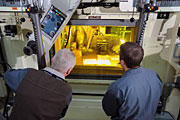- Number 356 |
- February 13, 2012
Pioneering microscopic nuclear fuel examination

The precautions necessary to
protect workers make irradiated
fuel sample preparation
extremely challenging for
researchers.
New nuclear fuel designs have the potential to last longer and bolster safety margins. Nano-scale examination helps researchers understand how fuels perform under prolonged irradiation, but such information has been difficult to obtain. Until now.
Researchers at DOE's Idaho National Laboratory have cleared a hurdle to examining irradiated fuel using a transmission electron microscope. This accomplishment has revealed behavior that suggests increased stability of a new type of reactor fuel. Further study and improvement in nuclear fuel performance are now much more attainable.
“If you look at the literature, microstructure information on irradiated fuel is very limited,” said Dennis Keiser, a researcher in INL’s Nuclear Fuels and Materials Division. “This new preparation technique will allow people with interest in different fuel types to potentially have access to new information about nuclear fuel behaviors at a very fine scale. It will also provide key information for computer models, which need data on a fine scale to make models that accurately represent fuels and materials behavior.”
Once a new fuel or material has been irradiated, researchers examine it to see how it performed. Cracks, bubbles or other irregularities warrant closer scrutiny.
Anyone who’s ever watched astronauts use the Space Shuttle Remote Manipulator to maneuver payloads can imagine how hard it would be to use such a device to perform a precise task such as, say, removing a splinter from a child’s finger.
That was the challenge facing researchers who wanted to examine irradiated nuclear fuel samples under a transmission electron microscope, or TEM, which can reveal features a few nanometers across. But to do so requires extremely thin samples that have been precisely polished and milled — processes that can shatter delicate pieces of irradiated nuclear fuel, which must initially be prepared using manipulator arms extending inside radioactive “hot cells.”
“You’re dealing with this brittle material that wants to break apart,” said Keiser. “The first question was, ‘Could we cut this small sample and have it stay together?’”
After practicing on less radioactive materials and refining methods by trial and error, INL researchers perfected their approach for preparing irradiated fuel samples. First, they home in on microscopic areas of interest. This approach makes the samples less radioactive and dangerous to deal with, eliminating the need for manipulators and hot cells.
Once they were able to obtain tiny, intact pieces from the fuel plate, they had to make the samples thin enough to analyze with a TEM. The new sample preparation technique — called “Focused Ion Beam In-Situ Lift-Out” — makes this possible. It mills the material with an ion beam to yield sections that are just tens of nanometers thick, which can reveal new features under a transmission electron microscope.
“Based on the literature, no one has reported doing this on irradiated fuel," Keiser said. "And our colleagues around the world were skeptical that we would be successful.”[Nicole Stricker, 208.526.5955,
nicole.stricker@inl.gov]
